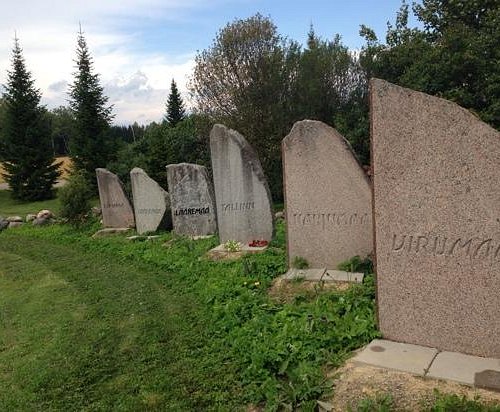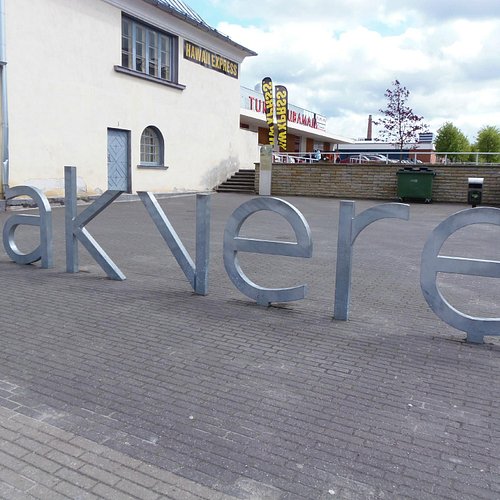Top 10 Monuments & Statues in Estonia, Estonia
– in Europe (green & grey)
– in the European Union (green) – [Legend]
Restaurants in Estonia
1. Pilistvere Memorial
Overall Ratings
5.0 based on 4 reviews
Pilistvere Memorial is a tomb piled up from stones with a cross in front of the tomb. By carrying stones to the bottom of the cross Estonians remember their fellowmen who were deported to Siberia. This is a place were all Estonians who lost someone during the deportation can come to as to a symbolic grave and to honour them.
2. Memorial Tablet of the Northern Sons of Finland
Overall Ratings
5.0 based on 2 reviews
A black granite memorial tablet bearing almost 200 names was installed on the wall of the Valga Jaani (St John’s) Church in 1934 in remembrance of the Finnish volunteers who fell in the Paju Battle of the War of Independence. The polar bear sign of the Northern Sons Regiment is shown on the shield above the stone. In 1940 the memorial tablet was demolished with pickaxes by the order of communists. The memorial tablet was reopened on the 80th anniversary of the Paju Battle in 1999.Interesting facts:* the memorial tablet was opened in 1934 by President Konstantin Pats;* the first table was made in Finland and the second one in Tartu;* donations for the second tablet were collected by Ylistaro Rural Municipality (Finland) at the initiative of Ossi Salo.
3. Monument to Merikula Paratroopers
4. Rakvere's Central Square
Overall Ratings
4.5 based on 50 reviews
If you’re tired from exploring the museums and traipsing up and down Vallimägi hill, the best place to take the weight off your feet is Rakvere’s central square, which was constructed in 2004. Kids will have fun running around on the bumps and other features and riding the toy animals. The contemporary bus pavilion, the yellow domes in the square and the fountain create a modern and interesting atmosphere.Did you know…?*The central square in Rakvere has been home to a sculpture dedicated to honorary citizen Arvo Pärt entitled 'Young man on bicycle listening to music' since 11 September 2010
5. Siivertsi Memorial
Overall Ratings
4.5 based on 6 reviews
Siivertsi memorial was built to honor protectors of homeland who died fighting near Narva in the Estonian War of Independence in 1918 to 1920. It was demolish in the time of World War II. Restored in 1996 by architect Melnik.
6. Pushkin Statue
7. Monument to Alfred Neuland
Overall Ratings
4.5 based on 6 reviews
Weightlifter Alfred Neuland (1895-1966) who was born in Valga is the first Estonian Olympic Champion. He returned with a gold medal from the Antwerp Olympic Games in 1920. He was also successful at the Paris Olympic Games where he won the silver medal.Interesting facts:* sculptor Mati Karmin is the author of the bronze bust;* Hermann Lerchenbaum, the first Estonian known to have taken part in Olympic Games as a member of the US Navy's rowing team at the 1896 Olympic Games in Athens, was also born in Valga.
8. Nipernaadi
Overall Ratings
4.5 based on 7 reviews
NIPERNAADI, the eternal wanderer and dreamer, greets visitors and boldly raises his hat in the Sade park. Look at the sole of his raised travelling boot and you'll see adventurous roads awaiting for you. If you manage to polish even the smallest part of it you will always have good luck accompanying your travels. Look into his eyes and you'll start dreaming, too. If you happen to meet his eyes for a bit longer your longing will be filled with something beautiful and unusual. Wave him as you leave and adventures will follow.NIPERNAADI, a vigorous bronze sculpture inspired by the protagonist of the novel "Toomas Nipernaadi" by August Gailit is anxious to meet you.
9. Statue of Raimond Valgre
Overall Ratings
4.5 based on 61 reviews
The musician Raimond Valgre who played in Parnu in 1930s and brought the town a lot of fame, can today be found sitting in the park near Kuursaal, as a bronze statue. The author of the statue is Rait Parg.You too can sit down next to the beloved Estonian composer and enjoy his beautiful compositions. Also be sure to go to the traditional Homage to Valgre musical night that takes place every summer, when Estonian star singers perform Valgre's immortal songs at the outdoor stage.
Reviewed By warboys - Huntingdon, United Kingdom
Nice to see what the Estonian composer looked like. The bronze statue is sitting in the park with his accordion, the music can be heard as you approach the statue.
10. Pimeaed
Overall Ratings
4.5 based on 14 reviews
This is Narva’s oldest part, an example of park architecture from the end of the 19th century. Located on the Victoria Bastion. There are two memorials in the park and its environs. The first is the iron cross erected on the Victoria Basion in 1853 in memory of the Russian soldiers that died during the Siege of Narva in the Great Northern War. The second memorial marks the graves of soldiers that died in the War of Independence in November 1918.










